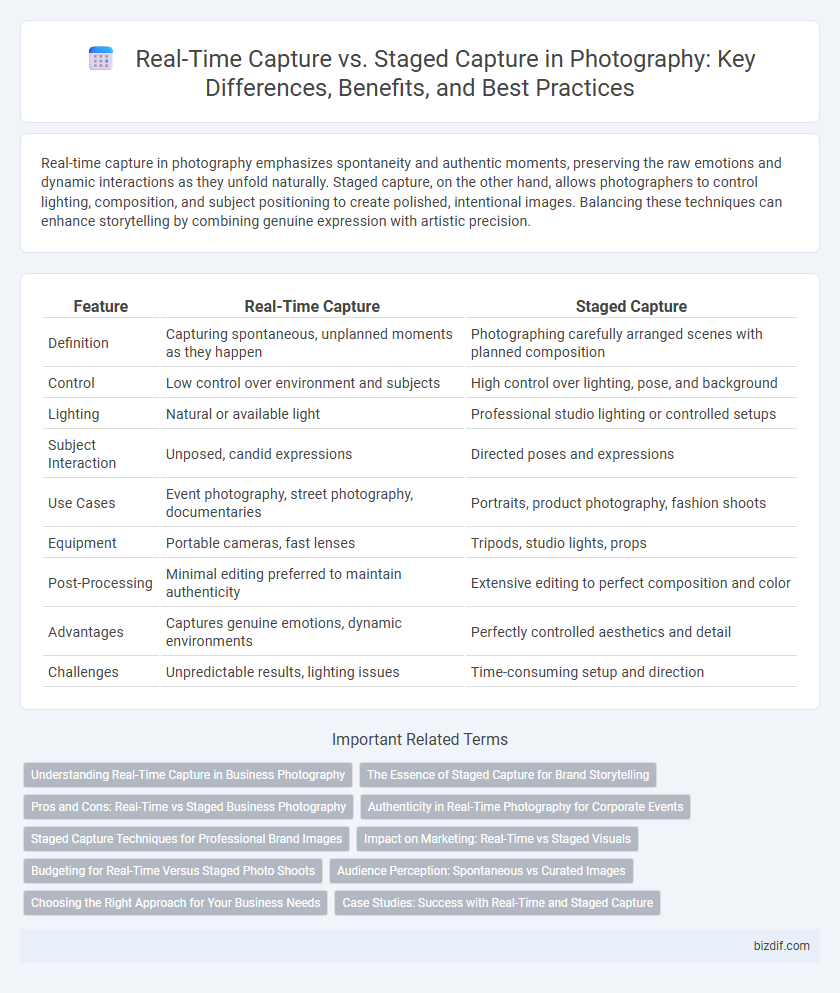Real-time capture in photography emphasizes spontaneity and authentic moments, preserving the raw emotions and dynamic interactions as they unfold naturally. Staged capture, on the other hand, allows photographers to control lighting, composition, and subject positioning to create polished, intentional images. Balancing these techniques can enhance storytelling by combining genuine expression with artistic precision.
Table of Comparison
| Feature | Real-Time Capture | Staged Capture |
|---|---|---|
| Definition | Capturing spontaneous, unplanned moments as they happen | Photographing carefully arranged scenes with planned composition |
| Control | Low control over environment and subjects | High control over lighting, pose, and background |
| Lighting | Natural or available light | Professional studio lighting or controlled setups |
| Subject Interaction | Unposed, candid expressions | Directed poses and expressions |
| Use Cases | Event photography, street photography, documentaries | Portraits, product photography, fashion shoots |
| Equipment | Portable cameras, fast lenses | Tripods, studio lights, props |
| Post-Processing | Minimal editing preferred to maintain authenticity | Extensive editing to perfect composition and color |
| Advantages | Captures genuine emotions, dynamic environments | Perfectly controlled aesthetics and detail |
| Challenges | Unpredictable results, lighting issues | Time-consuming setup and direction |
Understanding Real-Time Capture in Business Photography
Real-time capture in business photography emphasizes capturing authentic, spontaneous moments that convey genuine interactions and emotions, enhancing brand storytelling and customer engagement. It relies on fast, unobtrusive techniques and advanced camera technology to document events or environments as they naturally unfold, ensuring an honest and relatable visual narrative. This approach contrasts with staged capture, which involves carefully planned compositions and controlled settings, often appearing less authentic to modern audiences.
The Essence of Staged Capture for Brand Storytelling
Staged capture allows photographers to meticulously craft each element, ensuring the visual narrative aligns perfectly with brand identity and messaging. This deliberate setup emphasizes controlled lighting, composition, and props to evoke specific emotions and reinforce the brand's core values. Harnessing staged capture in brand storytelling creates compelling, cohesive imagery that resonates deeply with target audiences.
Pros and Cons: Real-Time vs Staged Business Photography
Real-time business photography captures authentic, spontaneous moments that convey genuine emotion and dynamic interaction, enhancing brand credibility and engagement. Staged capture allows precise control over lighting, composition, and branding elements, producing polished images tailored to specific marketing goals but may lack natural authenticity. Choosing between real-time and staged photography depends on the brand's need for authenticity versus visual perfection, balancing immediacy with crafted presentation.
Authenticity in Real-Time Photography for Corporate Events
Real-time capture in corporate event photography ensures authentic moments by documenting spontaneous interactions and genuine emotions as they unfold, avoiding the artificiality often present in staged photos. This approach leverages advanced camera technology and skilled photographers to seamlessly blend into the environment, preserving the natural atmosphere and energy of the event. Authentic images foster trust and connection, making real-time photography a valuable asset for corporate branding and communication.
Staged Capture Techniques for Professional Brand Images
Staged capture techniques in professional brand photography involve meticulous planning of lighting, composition, and props to create visually compelling images that align with brand identity. Photographers use controlled environments and precise post-processing methods to enhance product features and convey desired brand messages effectively. This approach ensures consistent, high-quality visuals that resonate with target audiences and elevate brand perception.
Impact on Marketing: Real-Time vs Staged Visuals
Real-time capture delivers authentic, spontaneous visuals that resonate with audiences by showcasing genuine emotions and unfiltered moments, enhancing brand trust and engagement. Staged capture allows precise control over composition, lighting, and subjects, producing polished images ideal for conveying a specific brand message or aesthetic. Marketing campaigns leveraging a mix of both styles can maximize audience connection by balancing authenticity with visual consistency.
Budgeting for Real-Time Versus Staged Photo Shoots
Budgeting for real-time photo shoots often involves higher costs due to the need for rapid equipment setup, on-location permits, and unpredictable variables that require contingency planning. In contrast, staged photo shoots allow for more controlled environments, minimizing unexpected expenses and enabling cost-efficient allocation of resources such as lighting, props, and talent scheduling. Producers must weigh the dynamic nature of real-time capture against the structured predictability of staged shoots to optimize financial planning and project outcomes.
Audience Perception: Spontaneous vs Curated Images
Real-time capture delivers spontaneous images that audiences often perceive as authentic and emotionally engaging, reflecting genuine moments without manipulation. Staged capture, in contrast, produces curated visuals that convey a polished and intentional narrative, appealing to viewers through composition and controlled aesthetics. Audience perception tends to value real-time shots for their raw honesty, while appreciating staged images for their artistic precision and storytelling.
Choosing the Right Approach for Your Business Needs
Selecting between real-time capture and staged capture depends on your business goals, target audience, and project requirements within the photography industry. Real-time capture excels in dynamic environments like events, sports, or news where authenticity and spontaneity drive engagement, while staged capture suits commercial, fashion, or product photography where control over lighting, composition, and detail precision enhances brand storytelling. Analyzing client expectations, budget constraints, and project timelines ensures the chosen approach delivers optimal visual impact and aligns with overall marketing strategies.
Case Studies: Success with Real-Time and Staged Capture
Case studies reveal that real-time capture excels in dynamic environments like sports photography, where moments unfold unpredictably and require immediate responsiveness, exemplified by the iconic shots from the Olympics. Conversely, staged capture proves effective in controlled settings such as commercial product photography, where meticulous composition and lighting result in polished and market-ready images, demonstrated by successful advertising campaigns for major brands. Both methods leverage specific technical and creative strengths to achieve distinct visual storytelling goals.
Real-Time Capture vs Staged Capture Infographic

 bizdif.com
bizdif.com